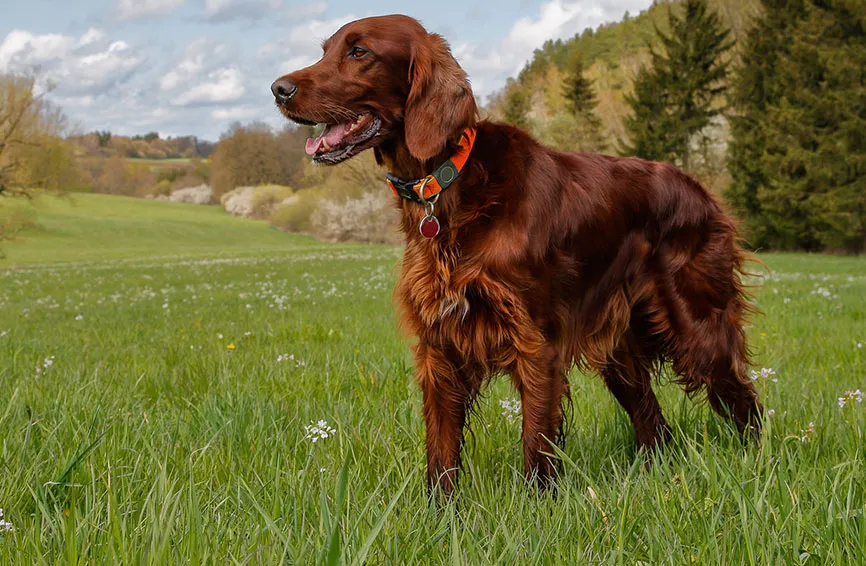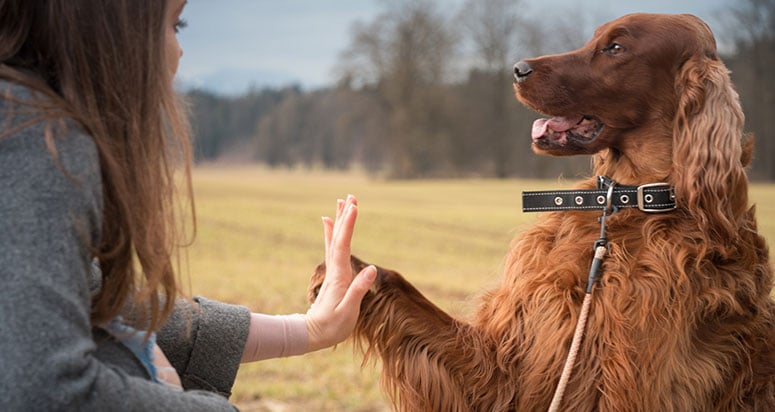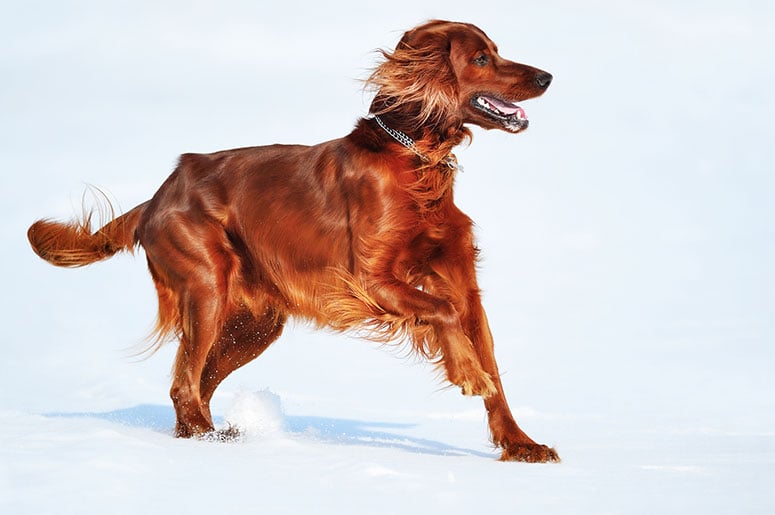Introduction to Irish Setters
Outgoing and sweet by nature, Irish setters are Sporting Group dogs loved by many families. They love playing with kids and chasing balls, and they have beautiful red coats that stand out for their unique color. Irish setters are eager to please people and have high energy levels that require plenty of exercise. They do well with outdoor activities and canine sports, with a desirable size that works well in many households.
Read on to learn more about the Irish setter breed and how to take the best care of this dog’s health.
Irish Setters Size
A fully grown Irish setter female will weigh about 60 pounds, and an adult male will weigh around 70 pounds. Females stand about 25 inches tall, with males about 27 inches tall. Irish setters reach their final height by one year of age but may gain weight for a few months longer.
Here’s how big you can expect your Irish setter to get as the dog grows from puppyhood to adulthood:
| Weight Chart | 4 months | 6 months | 10 months | 12 months | 18 months |
| Male Irish setters | 30 lbs. | 40 lbs. | 55 lbs. | 60 lbs. | 70-72 lbs. |
| Female Irish setters | 28 lbs. | 38 lbs. | 46 lbs. | 56 lbs. | 58-60 lbs. |
Irish Setters Characteristics
Irish setters are very friendly dogs that do slightly better in cold weather than in hot weather. They are friendly to pretty much everyone they meet, including strangers, kids, and other dogs. They have moderate grooming needs and are easy to train compared to other breeds. Their exercise needs are high, and they love to play with family members. You might find an Irish setter to be mischievous and inquisitive beyond just the puppy phase.
As you get to know an Irish setter’s personality, here’s what you can expect based on his or her breed characteristics:
| Breed Characteristic | Level (High, Medium, Low) |
| Affectionate with People | High |
| Good with Kids | High |
| Good with Pets | High |
| Need for Exercise | High |
| Energy Level | High |
| Intelligence Level | High |
| Able to Be Trained | High |
| Amount of Barking | Medium |
| Amount of Shedding | Medium |
History of Irish Setters
As the name suggests, the Irish setter comes from Ireland, where huntsmen bred them to be sleek and swift hunters who were able to cover plenty of ground in the vast countryside. These dogs were bred to run and hunt on flat and wide terrain, as opposed to the Gordon setter from Scotland, which was bred to navigate rocky and harsh lands. With their excellent sense of smell, early Irish setters specialized in locating gamebirds. They would find birds by “setting” down on their bellies, hence the name “setter.” Today’s Irish setters who work as hunting dogs accompany hunters with rifles.
But beyond the hunting fields, the Irish setter has gained popularity because of its success in show rings during dog competitions. The first Irish setter came to the U.S. in 1875, and the American Kennel Club recognized the breed in 1878. Many Irish setters have won competitions and been companions to famous people, including former U.S. president Richard Nixon. The “Big Red” books and movie featuring an Irish setter made the dog especially popular in the 1960s and 1970s.
Irish Setter Standard Information
These fun-loving dogs have certain characteristics that distinguish them from other setter breeds. They have an aristocratic vibe and elegant build, for example. Irish setters are swift hunters, trainable companions, and sweet-natured dogs that are balanced and beautiful.
Here is an overview of the breed standard information for the Irish setter:
Head:
- Long and lean head with delicate chiseling
- Soft and alert expression
- Almond-shaped, medium-sized eyes
- Ears set well back and low
- Moderately deep muzzle
- Teeth meet in scissors bite
Neck, Topline, Body:
- Moderately long and strong neck
- Tail set on nearly level and strong at the root
- Body long enough to allow a straight and free stride
- Chest deep and of moderate width
Forequarters:
- Shoulder blades long, wide, and sloping
- Forelegs straight and sinewy
- Feet small and firm with arched toes
Hindquarters:
- Wide and powerful hindquarters
- Well-angulated at stifle and hock joints
- Feet the same as in the front
Coat:
- Short and fine coat on head and forelegs
- Moderate length and flat coat on all other body parts
- Feathering coat as straight as possible
Color:
- Mahogany or rich chestnut red
- No black coloration
- Small amount of white is allowed on the chest, throat, toes, or streak on the skull
Gait:
- Big, lively, graceful, and efficient gait
- Head reaches slightly forward at an extended trot
Caring for Irish Setters
Irish setters are not apartment dogs and need plenty of space to run and roam around. They need lots of exercise to be happy and healthy, and they enjoy long runs and having a job to do. You’ll need to have a firm but gentle demeanor to train an Irish setter. These dogs do not make great guard dogs because they are so friendly with other people, even those they have never met before. They do well with children but may be a bit too rambunctious with small toddlers who could topple over easily while roughhousing.
Here are some general tips for taking the best care of an Irish setter:
Best Living Environments:
- Houses with fenced yards
- Properties with acreage
- No apartments
Type of Exercise:
- At least an hour of exercise daily
- Running around a yard
- Hikes and walks with family members
- Can be trained to hunt
Mental Enrichment:
- Keep mentally stimulated to avoid separation anxiety and destructive behavior
- Obstacle courses that require agility and athleticism
Training Strategies:
- Excellent at obedience training and agility competitions
- Can be trained to be therapy dogs
- Training will take patience due to their puppy-like enthusiasm
- It may take until age two or longer to reach maturity
Grooming Tips:
- Silky coats can easily become tangled
- Moderate shedders
- Need to groom daily or every other day
Irish Setters Common Health Problems
The average life expectancy of an Irish setter is 12 to 15 years. One of the best things that you can do to prolong the healthy life of an Irish setter is to enroll your pup in Healthy Paws pet insurance so that you can always afford to vet treatments without worrying about the cost.
These are some of the most common health issues that arise with Irish setters:
- Hip dysplasia (hereditary condition of the hip joint)
- Hypothyroidism (thyroid gland disorder)
- Osteochondrosis dissecans (orthopedic condition involving stiff joints)
- Canine leukocyte adhesion deficiency (inherited abnormality of the immune system)
- Progressive retinal atrophy (degenerative eye disorder)
- Epilepsy (seizures)
- Gastric torsion (bloat)
- Hypertrophic osteodystrophy (developmental bone disease that often affects puppies)
- Panosteitis (bone disease)
Diet and Nutrition for Irish Setters
The average Irish setter needs between two and three cups of dry dog food per day. Divide this total amount into morning and daily meals and not right before or after exercise to prevent bloat.
Where to Adopt or Purchase Irish Setters
If you want to purchase a purebred Irish setter puppy, the Irish Setter Club of America is a good resource because it offers a reputable breeder directory. The AKC Marketplace also lists AKC-registered litters and breeders on its website. To adopt an Irish setter in need of a loving home, you can find rescue organizations that specialize in this breed, such as Save Our Setters, which offers opportunities to adopt, foster, and help transport dogs to new homes.
Related Breeds
Irish setters are amazing dogs, but if you love this breed, you might also be interested to learn about similar breeds of dogs that share common characteristics. Here are some examples to consider before deciding to adopt or purchase an Irish setter:
- English setter
- Gordon setter
- Irish red and white setter
Pet Insurance for Irish Setters
Because of how active and rambunctious Irish setters are, it is common for these dogs to get into accidents, especially when they are puppies or reaching older age when they can’t do everything they used to. There are also various genetic conditions that Irish setters are prone to because of how they have been bred over the years, and no dog breed is immune to the deteriorating effects of aging.
For all of these reasons, pet parents choose Healthy Paws pet insurance for peace of mind. Healthy Paws’ Irish setter insurance plans cover accidents, illnesses, cancer, emergency care, genetic and hereditary conditions, breed-specific conditions and alternative care when your dog needs it most. We’ve enrolled over 560,000 pets and offer flexible premium and deductible options to fit your budget and your dog’s needs.
Request your Irish setter dog insurance quote on our website today, and rest assured that you will be prepared for whatever happens in your pet’s future.














